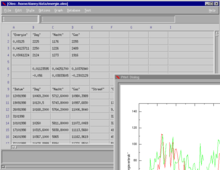 Oleo with a Motif GUI Oleo with a Motif GUI | |
| Original author(s) | Tom Lord, |
|---|---|
| Initial release | 1992; 33 years ago (1992) |
| Final release | 1.6.16 |
| Preview release | 1.99.16 |
| Written in | C |
| Type | Spreadsheet |
| License | GPL-3.0-or-later |
| Website | www |
GNU Oleo is a discontinued lightweight free software spreadsheet originally designed as a text-based spreadsheet using the curses library. The last development version of Oleo, 1.99.16, was released in 2001.
History
The project was started in 1992 by Tom Lord, and became part of the GNU initiative around 1994. At the time, the only open source alternative was the older text-based sc, both products having similar functionality to early versions of Lotus 1-2-3 or Microsoft Excel. Oleo's key bindings however were inspired from the Unix world, and similar to those used by the emacs editor, which frustrated novice users familiar with the DOS counterparts. Oleo and sc were the first Unix spreadsheet applications to acquire a graphical user interface. Because Oleo was officially part of the GNU project, it was dubbed "GNU's response to Excel" in a 1996 article in iX magazine. It claimed to be "better than the high priced spread", a reference to old oleomargarine advertisements promoting margarine over the more expensive butter. Oleo also worked well in a BSD environment; a FreeBSD port was available.
By 1995, sc had acquired an X Window front-end called xspread, which added graphics capabilities. In 1998, Oleo acquired a Motif-like GUI, relying on the royalty-free LessTif widget set. A GTK version was also under development. By 1999 Oleo was still judged as "not completely usable", due to the awkward graphical interface lacking in user friendliness like X-style cut, copy, and paste or tear-off menus. In the 1995 version, to type a number into a cell the user had to hit the "=" key first, similar to the early versions of Excel. This was later changed to typing a number directly, although typing a number in a cell that already contains one appends to it rather than overwrite it. Graphics are drawn using the device-independent library libplot, the centerpiece of the GNU plotutils. Oleo offers spreadsheet access to the GNU Scientific Library, a large collection of mathematical functions. It also offers some database connectivity, allowing access to MySQL database via queries, Xbase and DBF file access. It has support for macro programming, and for printing purposes it supports ASCII and PostScript output. Still, by 2000 it could not import Excel spreadsheets, while newer open source alternatives like Gnumeric offered this feature, and could also import Oleo spreadsheets.
Oleo was still recommended as a console spreadsheet application in a 2005 article in Linux.com, but the reviewer warns that "I had expected Oleo to be more intuitive, but I needed multiple sessions with the info file before I could use it proficiently. Even cell reference syntax was not what I had expected." By default, Oleo uses numbers for both rows and columns; a cell reference uses a syntax like r12c26. A single Oleo process does not support the display of more than one file at a time, but GNU screen or multiple terminals can be used as a work-around. Oleo supports editing the same spreadsheet in concurrent application instances.
References
- ^ https://www.gnu.org/software/oleo/ChangeLog
- "ChangeLog". 22 November 2000. Archived from the original on 8 January 2001.
- "Oleo - GNU Project - Free Software Foundation". 10 March 2001. Archived from the original on 1 April 2001.
- "oleo - Summary [Savannah]". savannah.gnu.org. 2001-01-23. Retrieved 2024-02-18.
Development Status: ? - Orphaned/Unmaintained
- "Oleo - GNU Project - Free Software Foundation)". GNU.org. 2016-05-11. Retrieved 2023-10-21.
- ^ Clifford Smith, "Spreadsheets under BSD (part 2)". Archived from the original on February 24, 2001. Retrieved 2010-01-17.
{{cite web}}: CS1 maint: bot: original URL status unknown (link), BSD Today, August 2000 - ^ "Novice to Novice | Linux Journal". www.linuxjournal.com. Retrieved 2023-10-21.
- ^ "The Xxl Spreadsheet Project | Linux Journal". www.linuxjournal.com. Retrieved 2023-10-21.
- online, heise (1996-03-17). "GNU mal wieder". iX Magazin (in German). Retrieved 2023-10-21.
- "Oleo 1.99.13". www.gnu.org. Retrieved 2023-10-21.
- "xxl: A Free Spreadsheet for Linux | Linux Journal". www.linuxjournal.com. Retrieved 2023-10-21.
- ^ "Oleo: a commandline spreadsheet". Tux Training. Archived from the original on 2008-10-06.
- ^ "Articles about Code Red are invading the Internet". Linux.com. 2001-08-06. Retrieved 2023-10-21.
- Hall, Michael. "Suites for the Sweet: GNOME Office". LinuxPlanet. Archived from the original on 2000-08-23.
External links
| Spreadsheets | |
|---|---|
| Free and open-source | |
| Proprietary freeware |
|
| Retail |
|
| Discontinued | |
| GNU Project | |
|---|---|
| History | |
| Licenses | |
| Software |
|
| Contributors | |
| Other topics | |
- AI Spreadsheet. Sourcetable Inc., 2024. Retrieved 2024-11-14.